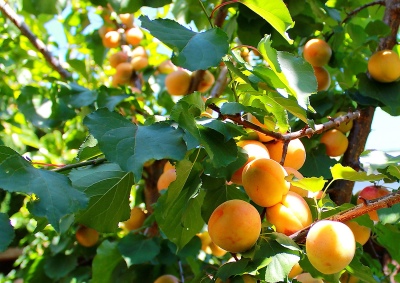
- Name synonyms: mandshurica
- Tree height, m: to 10
- Escapes: green or reddish brown, shiny
- Flowers: large, light pink
- Fruit weight, g: 15-20
- Fruit shape: oval
- Skin : pubescent
- Fruit color: orange-yellow
- Pulp (consistency): dense, dryish
- Fruit taste: sweet and sour
The Manchurian variety gained popularity due to its high decorative qualities, especially during flowering. During this period, the apricot, strewn with a large number of flowers, will become an adornment of any garden or land plot. Even with the onset of autumn, its appearance remains at its best due to the bright color of the foliage. The fruit crop differs from other apricot varieties in its longevity, since its life span is more than a century. Trees are often used for group plantings.
Description of the variety
Mature trees reach a height of up to 10 meters, but sometimes you can find 15-meter specimens. These are vigorous plants with a thickened and spreading crown. The shoots are covered with shiny bark, its color can be reddish-brown or green. The trunk is covered with rough and tough bark with deep cracks. Some gardeners perceive them as a symptom of a disease, but this is a characteristic feature of the variety.
Large and numerous flowers of light pink color open even before the foliage appears. The color of the leaves changes with the seasons. In the spring they are light green, and in the summer they become more saturated, green. The length is 5 to 12 centimeters. The shape is lanceolate-oval or broadly oval.
Fruit characteristics
Fruit weight varies from 15 to 20 grams. The sizes are average. Oval shape, standard for apricot. The color is bright, orange, with a yellow tint. During fruiting, the trees appear yellow from a distance due to the large amount of fruit. The skin is covered with light and light fluff.
Inside, a dense and slightly dry pulp grows. The large bone is easily detached from the fruit. Apricots are stored for up to two weeks. Fruits are considered dietary and contain a large amount of antioxidants and other beneficial trace elements.
Taste qualities
Many gardeners who are personally familiar with this variety consider the taste of the fruit to be specific. It contains both sweet and sour notes. You can make compote, juice, preserves, confiture, jam and many other delicacies from the harvest. Fruit is also great for eating fresh.
Ripening and fruiting
Only in the fifth year after planting the seedlings can you get the first portion of the crop. Trees bloom from late April to early next month, and fruiting occurs in summer - from late July to early August. Ripening periods are average.

Yield
Excellent yield is the main characteristic of the Manchurian variety. Even with the observance of the simplest requirements of agricultural technology, it will be possible to collect a rich harvest. On average, the return from one tree is from 45 to 60 kilograms. Universal fruits are highly transportable.When transported over long distances, fruits retain their attractive appearance, rich taste and aroma.
This is interesting: the amount of apricots depends on the size of the crown.
Self-fertility and the need for pollinators
This variety is self-fertile. In certain regions, trees begin to bloom in early April. The process continues for 12 days. Within the boundaries of the northern regions, the buds open after the snow melts and melts. Flowers attract wasps and bees with colorful petals and a vibrant honey scent. It is they who are the pollinators of fruit trees.
Growing and care
Standard care consists of performing the following activities:
- in a dry season, it is advisable to water the trees with warm and settled water (a lack of moisture will lead to dryness of the fruit);
- to retain moisture, the ground in the near-trunk circle is covered with organic mulch (hay, dry grass, straw);
- root fertilizers are applied 2 times per season;
- periodically loosening of the soil is carried out within a radius of 2-2.5 meters from the tree;
- in spring and autumn, the trunk is covered with whitewash, which will protect the garden from pests;
- all dry, old and deformed branches are removed, and the cuts must be treated with a garden garden to avoid infection (the tool used for work must also be sharp and clean).
Manchurian apricot is highly resistant to both drought and cold. Low or high temperatures will not affect fruiting and tree health. Plots with drained soil are suitable for growing the variety. The best options are sandy loam or light loamy soil. The acidity reaction should be neutral.
Also, the variety is actively developing in a sunny or slightly shaded area. Sanitary pruning is often done as needed, but experienced gardeners recommend doing it in early spring.



































































